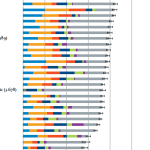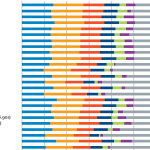In human societies there will always be differences of views and interests. But the reality today is that we are all interdependent and have to co-exist on this small planet. Therefore, the only sensible and intelligent way of resolving differences and clashes of interests, whether between individuals or nations, is through dialogue. The promotion of a culture of dialogue and non-violence for the future of mankind is thus an important task of the international community.
His Holiness the Dalai Lama
in a speech to the “Forum 2000” Conference,
Prague, Czech Republic, 4 September 1997
During this few weeks, the term “Culture of Dialogue” has been publicly conceptualized and verbalized. The two prominent leaders of Cambodia ie. Prime Minister Hun Sen of government leadership, and HE Sam Rainsy of main opposition CNRP leadership, have transformed the coinage of this term into tangible implementation. This term is rare in Cambodia politics to be heard and convinced by the Khmer politicians. Sometime, we have heard about it but not at the intention of implanting it concretely or making it a grand policy by the Cambodian leaders.
Looking back
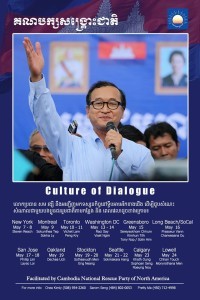 “Culture of Dialogue” is not new in the context of daily use for common communication. Humankind has communicated with each other at least since the birth of human social establishment. But when this term has developed and evolved itself into more professional level, the Culture of Dialogue ideally means a norm or guidance of a shared exploration towards greater understanding, connection and possibility.
“Culture of Dialogue” is not new in the context of daily use for common communication. Humankind has communicated with each other at least since the birth of human social establishment. But when this term has developed and evolved itself into more professional level, the Culture of Dialogue ideally means a norm or guidance of a shared exploration towards greater understanding, connection and possibility.
Considering the dilemma of embedded human conflicts, which Aristotle formalized human beings are “social animals”, the World War I and World War II is the testament of this conflict nature, but Enlightenment theory such as Buddha and Voltaire before Christian era and during the 16th century, had paved foundation for the world’s leaders to halting confrontational nature by using diplomatic means of dialogue to completely end the war and to shake hand for shared responsibility and collective development.
For Cambodia, we have developed this dialogue during the post-colonial 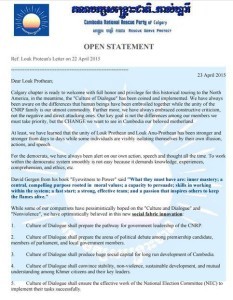 politics. Sangkum Reastre Niyum led by King Norodom Sihanouk was merely a domestic “dialogue” while his foreign policy as a non-aligned country is considered a dialogue approach. But that non-alignment policy was staying on a ridge in between two tigers: USA and China. The slippery ridge finally knocked Cambodia down to the bottom line of catastrophe during 1970 to 1990. During the effort to bring about national reconciliation and peace mediated by the United Nations, the Paris Peace Agreement was crafted, that was all achieved by “Culture of Dialogue”. But this culture has considerably faded away after that.
politics. Sangkum Reastre Niyum led by King Norodom Sihanouk was merely a domestic “dialogue” while his foreign policy as a non-aligned country is considered a dialogue approach. But that non-alignment policy was staying on a ridge in between two tigers: USA and China. The slippery ridge finally knocked Cambodia down to the bottom line of catastrophe during 1970 to 1990. During the effort to bring about national reconciliation and peace mediated by the United Nations, the Paris Peace Agreement was crafted, that was all achieved by “Culture of Dialogue”. But this culture has considerably faded away after that.
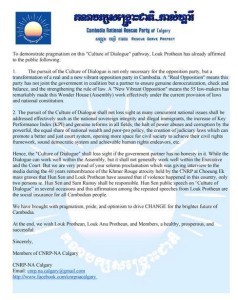 After the 2013 election, the embodiment of this culture promoted by HE Sam Rainsy and positively responded by Prime Minister Hun Sen has seen as the cornerstone for democratization and sustainable development in Cambodia if the two leaders shall always respect their speech and action, with no tricks in it and coercion to exploit this great grant policy.
After the 2013 election, the embodiment of this culture promoted by HE Sam Rainsy and positively responded by Prime Minister Hun Sen has seen as the cornerstone for democratization and sustainable development in Cambodia if the two leaders shall always respect their speech and action, with no tricks in it and coercion to exploit this great grant policy.
What should be done in general context
According to co-intelligence.org, there are sorts of dialogue dictated following:
- interpersonal dialogue in all relationships
- group dialogue as the norm in all groups and organizations
- intergroup dialogue among groups and organizations
- issue-oriented dialogue among stakeholders (in the case of conflicts and decision-making)
- community dialogue among citizens exploring and co-creating their shared future
- regular dialogue programs woven into coherent activities that have recognized roles in the community, organization or culture
- systemic dialogue which is the result of all of these and the context. It consists of a widespread expectation among people
- that dialogue will happen whenever there is need to settle disputes, make decisions or learn and grow together;
- that there are many forms of dialogue useful for various purposes which most people have a working knowledge of and access to expertise in; and
- that dialogue is a normal and desirable part of life — in relationships, groups, organizations, communities and culture.
When dialogue is systemic in a culture, it has been institutionalized: it shapes every institution from marriage to bureaucracy, from education to health care, from politics to business. Everyone in the culture is trying to explore, to connect with each other, to make things possible, and to learn and grow together.
- living dialogue involves a dialogic approach to aliveness wherever it exists — in people, in nature, in all situations. In this sense, it can be practiced as a spiritual discipline. It can become a characterstic quality of a life, a group, an entire culture.

